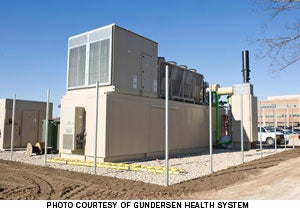Gundersen Health System campus achieves energy independence
 Part of Gundersen Health System, LaCrosse, Wis., has achieved a distinct and possibly unique status that the entire health system is on a mission to achieve by 2014: energy independence.
Part of Gundersen Health System, LaCrosse, Wis., has achieved a distinct and possibly unique status that the entire health system is on a mission to achieve by 2014: energy independence.
Jeff Rich, executive director, GL Envision LLC, a subsidiary of Gundersen Health System, says the system's Onalaska medical campus, which is located near LaCrosse, recently achieved energy independence by producing more British thermal units than it consumes. He says it is believed to be a first for any U.S. medical campus.
The campus achieved the status through a partnership with LaCrosse County, which pipes previously flared-off landfill methane gas to a generator installed at Gundersen's Onalaska campus. The generator produces electricity that is sold to Xcel Energy, sent to the grid and used by local homes and businesses. Exhaust heat from the generator's engine is captured and heats a glycol and water mix piped in a continuous loop to heat exchangers at the Onalaska Clinic and Support Services Building.
The system generates about $700,000 in annual revenue from electricity sold to the grid and reduces heating costs by about $100,000 each year, he says. The project produces additional revenue that reduces the campus energy bill substantially, eliminates fossil fuel emissions and frees up money for patient care, he notes.
The landfill gas-to-energy partnership with the county is part of Gundersen's Envision program, which is the health system's vision for environmental stewardship. As part of the program, Gundersen set a goal to become 100 percent energy independent — to produce more renewable energy than consumed from fossil fuel sources — by 2014.
Rich says Gundersen is about halfway to achieving its energy independence goal so far by implementing a variety of energy-efficiency actions that cut costs by about $1.25 million annually and also through renewable energy measures, including two wind turbine sites and a landfill project.
The gas-to-energy project represents about 11 percent of the health system's energy independence goal. A second wind turbine site that started operating in early June at Cashton, Wis., and the first wind turbine that began operation in December in Lewiston, Minn., together represent about 12 percent of Gundersen's energy objective, says Rich.




